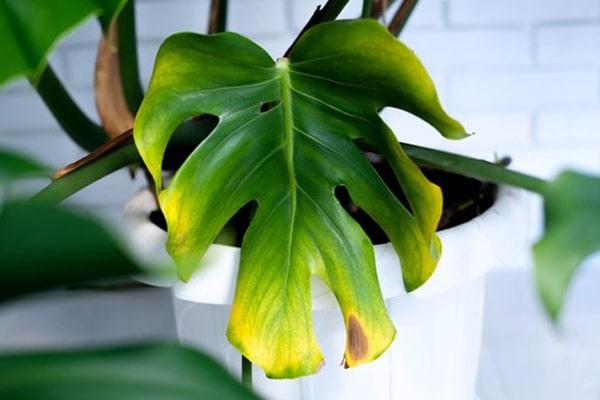Monstera deliciosa also known as a swiss cheese plant is a common indoor plant. It gets its nickname from the large holes that appear in its matured leaves.
When not indoors, monstera deliciosa can flower and produce edible fruit that tastes like a combination between a banana and a pineapple.
These evergreen plants are ideal to be kept indoors because they are easy to care for and sturdy. They can add a pop of colour to a room, help to clean the air, and they get so big that they can be a great statement piece.
Below we have outlined how to care for a monstera plant and get it healthy enough to develop those iconic holes in the leaves. If you want to learn more about taking care of houseplants and get answer to your gardening questions, you can visit Gardening FAQs website.
Contents []
Placement
The first step in owning a monstera is figuring out where it is going to go. Since it is a tropical plant, it enjoys a warm and humid environment.
Try to place it in bright indirect sunlight as you don’t want the leaves to burn. Like other indoor plants, the ideal temperature is between 65 and 85 degrees Fahrenheit. You want to avoid cold temperatures as best as you can.
Maintenance
When you first get your monstera you may need to aerate its soil as it is usually packed down during transit, next you need to assess its moisture levels. We go on more about watering later on in this article.
When it comes to the soil, you only need to fertilize it once per month during the growing period. You don’t need to fertilize in fall or winter.
Rotate your monstera periodically to ensure that every leaf gets sunlight and make sure you dust them frequently.
Since monstera enjoys humid environments, you can get a fine mister or a humidifier for it.
Monsteras are generally good at fighting off pests but sometimes you may need to wash the leaves with warm soapy water to kill them off. Just make sure you regularly check the leaves and properly take care of your monstera so they have the best chance at fighting them off.

They commonly grow outwards but you can use stakes to guide their growth upwards. Some monstera grow brown leaf-less sticks for this purpose, but you can trim them if you don’t like the look of them.
Watering

You always want to check the moisture level on your monstera before watering it. They enjoy slightly moist soil so it’s a good idea to let the top layer dry out a bit before watering it.
When the top 2-4 inches of the soil is dry then you can water it. This can be about 1-2 weeks between watering. You don’t want soggy soil as the monstera will be overwatered.
You can tell the plant is overwatered if there is yellow and brown spotting on the same leaf. On the other hand, if the leaves are drooping or are fully yellow with crispy brown spots then you are underwatering your monstera.
Repotting
Monstera plants grow fast so you will need to repot it after a year and a half to 2 years. You should aim to do so in spring or summer as that is when your monstera is strongest.
To allow your monstera to continue growing you should give it a slightly larger pot, about 4 inches more in diameter. You don’t want the pot to be too large as it can cause the roots to drown.
If you want to use the same pot then replace the soil and trim back some of the roots.
Monstera can develop aerial roots that may spill out of the pot. This is normal and isn’t a sign that it needs to be immediately repotted.
Because monstera doesn’t enjoy soggy soil, you want good drainage in your potting soil. This could include lava rock or perlite mixed into the soil. Try to include some drainage at the bottom of the pot as the monstera will absorb any water it needs and drain out the rest. Since it is an indoor plant don’t forget to put a tray under it to catch any drained water.
Final Thoughts
Monsteras are some of the most beginner-friendly plants. As long as you put them in the right spot and water them every couple of weeks then you will have a healthy plant.
Monstera are also good because they will tell you what they want, just look for the signs we previously stated in this article. You can make your monstera as large as you want, or prune back the leaves. As a plant, it is very low maintenance.
Just make sure you keep them away from small children and pets as ingestion of the leaves can make them sick.



